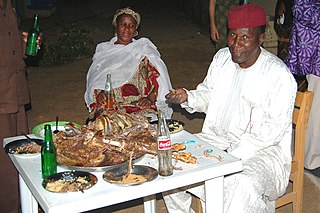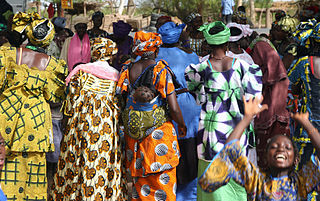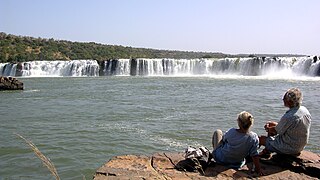| Part of a series on |
| Traditional African religions |
|---|
 |
Youga Dogorou is one of the Dogon villages in Mali. It is one of the Youga group of villages, the others being Youga Piri and Youga Na. The village is about 12km northeast of Banani. [1] [2]
| Part of a series on |
| Traditional African religions |
|---|
 |
Youga Dogorou is one of the Dogon villages in Mali. It is one of the Youga group of villages, the others being Youga Piri and Youga Na. The village is about 12km northeast of Banani. [1] [2]
Youga Dogorou is where the sacred Sigi festival—one of the most important Dogon religious festivals—takes place every 60 years. The long procession of the Sigi starts and ends in Youga Dogorou. [2] [3] [4] The last Sigi festival took place in 1967 and lasted until in 1973. The next one is due to take place in 2027 (as of 2020). [5] [2]
Like the other Youga villages, it is built on a small hill opposite the falaise. The village also host some well-preserved Tellem architecture. [2] [6]

Bamako is the capital and largest city of Mali, with a 2009 population of 1,810,366 and an estimated 2022 population of 2.81 million. It is located on the Niger River, near the rapids that divide the upper and middle Niger valleys in the southwestern part of the country.

The Dogon are an ethnic group indigenous to the central plateau region of Mali, in West Africa, south of the Niger bend, near the city of Bandiagara, and in Burkina Faso. The population numbers between 400,000 and 800,000. They speak the Dogon languages, which are considered to constitute an independent branch of the Niger–Congo language family, meaning that they are not closely related to any other languages.
Tahoua is a city in Niger and the administrative centre of the Department of Tahoua and the larger Tahoua Region. It is the fourth largest town in the country, with a population of 117,826.

Maradi is the second largest city in Niger and the administrative centre of Maradi Region. It is also the seat of the Maradi Department and an Urban Commune.

Banani is a village in Mali, populated by the Dogon people. Banani village is situated at the base and on the lower slopes of a mountain ridge. There is a steep road leading up to Sangha. Toro So is spoken in the village.

The Adrar des Ifoghas is a massif located in the Kidal Region of Mali, reaching into Algeria. It has an area of around 250,000 square kilometers.

The government and people of Niger observe twelve official public holidays. These include international commemorations, the commemoration of important dates in the history of Niger, and religious holidays. Both Christian and Muslim holidays are observed as official public holidays. While the former colonial power, France, instituted Christian observances, the vast majority of Nigeriens are Muslim.
A masquerade ceremony is a cultural or religious event involving the wearing of masks. In the Dogon religion, the traditional beliefs of the Dogon people of Mali, there are several mask dances, some of which include the Sigi festival. The Sigi entered the Guinness Book of Records as the "Longest religious ceremony."
The wildlife of Mali, composed of its flora and fauna, is widely varying from the Saharan desert zone to the Sahelian east–west zone, to Mali, a landlocked francophone country in North Africa; large swathes of Mali remain unpopulated but has three sub-equal vegetation zones; the country has Sahara Desert in the north, the Niger River Basin at its center and the Senegal River on the south.

The culture of Mali derives from the shared experience, as a colonial and post-colonial polity, and the interaction of the numerous cultures which make up the Malian people. What is today the nation of Mali was united first in the medieval period as the Mali Empire. While the current state does not include areas in the southwest, and is expanded far to the east and northeast, the dominant roles of the Mandé people is shared by the modern Mali, and the empire from which its name originates from.
Bamako Grand Mosque is a mosque in the city centre of Bamako, Mali. Built on the site of a pre-colonial mud-brick mosque, the current mosque was built through funding from the Saudi Arabian government at the end of the 1970s. One of the tallest structures in Bamako, it is situated north of the Niger River near the central market and the colonial-era Bamako Cathedral. With its tall cement minarets built around a square central structure, the building is stylistically closer to Saudi religious structures than West African. The mosque is visible from much of the city and is occasionally opened to tourists.

The Manding Mountains are a highland area in Mali, stretching between its western border with Guinea to an area 50km west of Bamako, Mali's capital. They reach 457 metres (1,499 ft) above sea level. Kangaba, the spiritual home of the Mandinka people, is located at the foot of the mountains.
Safir Hotels & Resorts is a Kuwaiti-owned luxury hotel chain in the Arabic world. Clientele includes the sister of the Emir of Kuwait who stayed in the hotel's $3000 a month apartments.

The Gouina Falls or Chutes de Gouina are on the Sénégal River in Mali between the towns of Bafoulabé (upstream) and Diamou (downstream) in the Kayes Region, where the river runs north from the Talari Gorges. They have been called the "Niagara falls of Mali". The river is about 500 m wide at this point, and drops 16 m over the falls. The volume of water is 12-13 m3 per second in the dry season, and up to 2430 m3 per second in the rainy season.

Dogon country is a region of eastern Mali and northwestern Burkina Faso populated mainly by the Dogon people, a diverse ethnic group in West Africa with diverse languages. Like the term Serer country occupied by the Serer ethnic group, Dogon country is vast, and lies southwest of the Niger River belt. The region is composed of three zones: the plateau, the escarpment and the Seno-Gondo plain.
Kokorou or Kokoro is a town and rural commune in the Téra Department of western Niger.
Malian literature is the literature of the modern country of Mali.
There is relatively limited tourism in Niger. Most of the tourism industry is in the north, where the city of Agadez allows access to the desert. Other places that see tourism are the capital city, Niamey, areas around the Niger River, and reserves such as Kouré which is known for West African giraffes.
The Lebe or Lewe is a Dogon religious, secret institution and primordial ancestor, who arose from a serpent. According to Dogon cosmogony, Lebe is the reincarnation of the first Dogon ancestor who, resurrected in the form of a snake, guided the Dogons from the Mandé to the cliff of Bandiagara where they are found today.

The Binou is a Dogon totemic, religious order and secret ceremonial practice which venerates the immortal ancestors. It can also mean a water serpent or protector of a family or clan in Dogon. It is one of the four tenets of Dogon religion—an African spirituality among the Dogon people of Mali. Although the Dogons' "Society of the Masks" is more well known, due in part to Dogon mask–dance culture which attracts huge tourism, it is only one aspect of Dogon religion, which apart from the worship of the Creator God Amma, a rather distant and abstract deity in the Dogon world-view, is above all made up of ancestor veneration. The Binou serves as one of the four aspects of Dogon religion's ancestor veneration. Other than the Binou and the worship of Amma, the other three aspects of the religion includes the veneration of Lebe, which pertains to an immortal ancestor (Lebe) who suffered a temporary death in Dogon primordial time but was resurrected by the Nommo; the veneration of souls; and lastly, the Society of the Masks, which relates to dead ancestors in general. These myths are in oral form—known to us in a secret language. They form the framework of Dogon's religious knowledge, and are the fixed Dogon's sources relating to the creation of the universe; the invention of fire, speech and culture.
Coordinates: 14°31′47″N3°13′13″W / 14.52972°N 3.22028°W